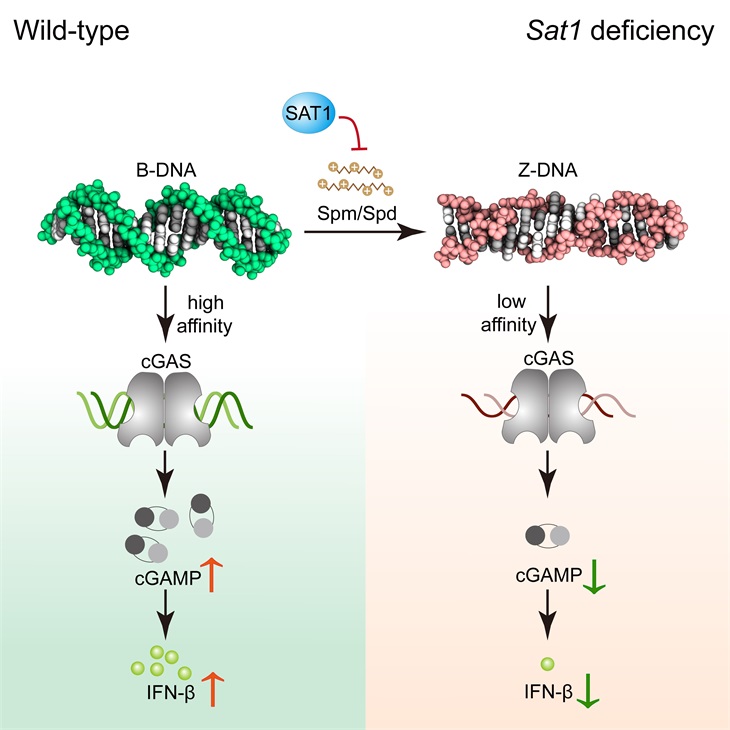Prof. Wei Zhao Group Reveals Novel Regulation Mechanisms of cGAS through B-to-Z DNA Transition
Source:Wei Zhao
2023-11-28
On Nov. 14th, the Cell Press journal IMMUNITY published the research article entitled "Polyamine metabolism controls B-to-Z DNA transition to orchestrate DNA sensor cGAS activity ". This study demonstrated a novel mechanism that polyamine metabolism regulates antiviral innate immune responses through controlling B-to-Z DNA transition. The assistant research fellow Chunyuan Zhao and Ph.D. candidate Yunjin Ma from the School of Biomedical Sciences of Shandong University are the co-first authors, and Prof. Wei Zhao from the School of Biomedical Sciences of Shandong University is the corresponding author.
The detection of microbial- or host-derived DNAs in the cytosol by cyclic GMP-AMP (cGAMP) synthase (cGAS) plays a crucial role in the immunity of many organisms. Upon double-stranded DNA engagement, cGAS catalyzes the conversion of GTP and ATP to cGAMP, which activates the downstream signaling effector stimulator of interferon genes (STING) to initiate type I interferon (IFN) expression and inflammatory responses. Additionally, cGAS mediates the protective immune response against microbial infections and participates in various non-infectious contexts such as inflammatory diseases, antitumor immunity, and cellular senescence. Therefore, precise regulation of cGAS activity is necessary to eliminate invading pathogens and prevent their detrimental effects.
cGAS recognizes adequate amounts of cytoplasmic DNA (cytoDNA) in a sequence-independent manner and triggers downstream signaling. B-DNA has a right-handed configuration and is the most common form of DNA under physiological conditions. Z-DNA has a left-handed configuration; the DNA backbone has a zigzag arrangement, which differs from the smooth continuous coil found in B-DNA. The distinct conformation of Z-DNA implies that its cGAS affinity may differ from that of B-DNA. However, the physiological regulation of the B-to-Z DNA transition and whether this transformation affects cGAS binding activity is unclear.
In this study, Zhao et al. performed an in vitro cGAS activity-screening assay using an endogenous metabolite library and identified that spermine and spermidine attenuated cGAMP production induced by 45-bp interferon-stimulating DNA. Immunoprecipitation and electrophoretic mobility shift assay showed that spermine and spermidine inhibited the binding of cGAS and DNA. Polyamines are highly charged aliphatic polycations that can bind to negatively charged nucleic acids. They further showed that spermine and spermidine bound to DNA and induced B-to-Z DNA transition. The binding affinity of B-DNA to cGAS was higher than that of Z-DNA, indicated that spermine and spermidine induce a B-to-Z DNA transition to reduce B-DNA concentrations in the cytoplasm and suppress the total amount of DNA-binding cGAS, thereby inhibiting cGAS activation. Furthermore, they found that HSV-1 infection decreased cellular polyamine, which is regulated by spermidine/spermine N1-acetyltransferase 1 (SAT1). SAT1 selectively facilitates cGAS activation by suppressing the B-to-Z DNA transition.

The highlights of this study include: (1) Spermine and spermidine induce B-to-Z dsDNA transition in vivo. (2) The binding affinity of Z-form dsDNA to cGAS was lower than that of B-DNA. (3) Spermine and spermidine attenuate cGAS activation by promoting B-to-Z DNA transition. (4) SAT1 facilitates cGAS activation by decreasing Spm/Spd level and Z-DNA accumulation.
This work was supported by grants from the National Natural Science Foundation of China, the Innovative Group Project of the Climbing Program of Shandong University, and Young Scholar’s Future Plan Cultivation Project of Shandong University.
Links: https://www.cell.com/immunity/fulltext/S1074-7613(23)00417-X
The detection of microbial- or host-derived DNAs in the cytosol by cyclic GMP-AMP (cGAMP) synthase (cGAS) plays a crucial role in the immunity of many organisms. Upon double-stranded DNA engagement, cGAS catalyzes the conversion of GTP and ATP to cGAMP, which activates the downstream signaling effector stimulator of interferon genes (STING) to initiate type I interferon (IFN) expression and inflammatory responses. Additionally, cGAS mediates the protective immune response against microbial infections and participates in various non-infectious contexts such as inflammatory diseases, antitumor immunity, and cellular senescence. Therefore, precise regulation of cGAS activity is necessary to eliminate invading pathogens and prevent their detrimental effects.
cGAS recognizes adequate amounts of cytoplasmic DNA (cytoDNA) in a sequence-independent manner and triggers downstream signaling. B-DNA has a right-handed configuration and is the most common form of DNA under physiological conditions. Z-DNA has a left-handed configuration; the DNA backbone has a zigzag arrangement, which differs from the smooth continuous coil found in B-DNA. The distinct conformation of Z-DNA implies that its cGAS affinity may differ from that of B-DNA. However, the physiological regulation of the B-to-Z DNA transition and whether this transformation affects cGAS binding activity is unclear.
In this study, Zhao et al. performed an in vitro cGAS activity-screening assay using an endogenous metabolite library and identified that spermine and spermidine attenuated cGAMP production induced by 45-bp interferon-stimulating DNA. Immunoprecipitation and electrophoretic mobility shift assay showed that spermine and spermidine inhibited the binding of cGAS and DNA. Polyamines are highly charged aliphatic polycations that can bind to negatively charged nucleic acids. They further showed that spermine and spermidine bound to DNA and induced B-to-Z DNA transition. The binding affinity of B-DNA to cGAS was higher than that of Z-DNA, indicated that spermine and spermidine induce a B-to-Z DNA transition to reduce B-DNA concentrations in the cytoplasm and suppress the total amount of DNA-binding cGAS, thereby inhibiting cGAS activation. Furthermore, they found that HSV-1 infection decreased cellular polyamine, which is regulated by spermidine/spermine N1-acetyltransferase 1 (SAT1). SAT1 selectively facilitates cGAS activation by suppressing the B-to-Z DNA transition.

The highlights of this study include: (1) Spermine and spermidine induce B-to-Z dsDNA transition in vivo. (2) The binding affinity of Z-form dsDNA to cGAS was lower than that of B-DNA. (3) Spermine and spermidine attenuate cGAS activation by promoting B-to-Z DNA transition. (4) SAT1 facilitates cGAS activation by decreasing Spm/Spd level and Z-DNA accumulation.
This work was supported by grants from the National Natural Science Foundation of China, the Innovative Group Project of the Climbing Program of Shandong University, and Young Scholar’s Future Plan Cultivation Project of Shandong University.
Links: https://www.cell.com/immunity/fulltext/S1074-7613(23)00417-X


